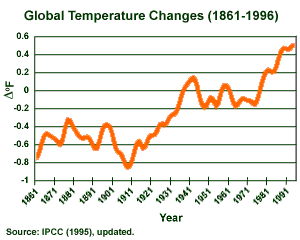CHANGING CLIMATE
Global surface temperatures have increased
0,6-1.2F since the 19th century. The 9 warmest years have all occurred
in the last 14 years of this century. Out of these 1995 has been the warmest
year recorded. Sea levels have increased 4-10 inches over the past century,
and the snow cover in the Northern Hemisphere has decreased. Worldwide
precipitation has also increased about 1%.
 With
increasing concentrations of greenhouse gases, it is likely to accelerate
the climate change. As the climate begins to warm the evaporation will
begin to increase, which will then increase the average global precipitation.
Soil moisture is also likely to decline in many regions, and severe rainstorms
are likely going to become more frequent.
With
increasing concentrations of greenhouse gases, it is likely to accelerate
the climate change. As the climate begins to warm the evaporation will
begin to increase, which will then increase the average global precipitation.
Soil moisture is also likely to decline in many regions, and severe rainstorms
are likely going to become more frequent.
IMPACTS
Rising global temperatures are expected
to raise sea level, and change precipitation and other climate conditions.
With regional climate changing it could alter forests, crop yields, and
water supplies. It could also threaten human health, and harm birds, fish,
and many different types of ecosystems. Deserts could expand into rangelands,
and the National Parks may be permanently altered. Many things will be
severely altered by Global Warming.



